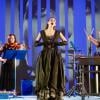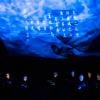
Beth Morrison is a singular figure in the landscape of American opera. Her award-winning productions have long leveraged her distinctive visual style in the service of new stories from new artistic voices.
Her company, Beth Morrison Projects (BMP), has been expanding horizons for 18 years, and Magdalene, which received its West Coast premiere last week at REDCAT, is a potent example of what BMP can accomplish. Written, directed, produced, and performed by women — including a cadre of 14 women composers who, in Morrison’s words, represent “the future of opera” — Magdalene is a testament to vision and collaborative spirit.
The opera sets poet Marie Howe’s highly affecting collection of the same name, populated with intense, pluralistic perspectives and layered meditations. Powered by two heroic lead performances at REDCAT on Wednesday evening, the work offered nuanced ruminations on womanhood.
But Magdalene’s form is really too compact for its expansive project. The 75-minute run time proved too brief a window in which to take in the totality of the libretto’s insight, and the narrative tension essential to opera’s capacity for storytelling was lacking here. Magdalene is an ambitious, moving work — an opera that deserves, but also demands, repeated viewing.

The opera’s central figure, as described by director Zoe Aja Moore and soprano and composer Danielle Birrittella in a postconcert talkback, is a “prismatic” archetype that invites all-encompassing projection. The creators’ approach channeled this pluralism in several forms — most notably, Birrittella was doubled by dancer and choreographer Ariana Daub in the title role.
Then there is the matter of the composers. Their instrumental score — for an ensemble of harp, string quartet, and electronics — engages Birrittella as a fellow chamber musician and responds with quiet intricacy to the vocal line. Save for a few climaxes, which often invoke electronics or extended techniques from the live players, the music dedicates itself largely to the careful development of quiet consonant figures.
Running quintuplets appear in the harp in Christina Courtin’s “Low Tide, Late August.” In the following movement, Leila Adu’s “The Landing,” the figure is taken up with a swaggering stomp by the string quartet, animating a moment of tautness in Daub’s choreography. The tension resolves as the harp returns.
But the moments of high drama are just as striking. “The Teacher,” penned by Birrittella herself, shimmers with a Luciano Berio-like ferocity, complete with venomous whispers and athletically controlled hyperventilation. Video designer Emilie Sabath’s projections cast a sickly pallor behind the performers in this movement. Kamala Sankaram’s “What I Did Wrong” places a thumping kick under sustained string playing, adding heaviness to the speaker’s isolation (“Who would follow that woman down the narrow hallway?”), though the synth-assisted groove initially faltered on Wednesday as the quartet lagged behind the track.

Impressively, the music possesses a remarkable sense of unity amid the libretto’s overlapping, nonlinear narratives. While such continuity might seem to reduce the composers’ sonic diversity, it is a necessary and welcome compromise that serves the work in light of its fractured libretto.
The speaker of Howe’s collection cycles through various points of view — from daughter to mother to abstract soul, from the contemporary to the atemporal. The operatic adaptation is deeply felt, but in performance, the work was too dense to be perceived fully as couplets sped by. Projecting each poem’s full text through the corresponding movements would have aided comprehension.
But the breathtaking, energetic exchange between the opera’s two stars helped to bring the main theme of the show into focus. Howe’s speakers share an interest in self-definition. While the opera’s breakneck pace risks obscuring this idea, it nonetheless shone strongly in the pair’s movements, the two performers mirroring, interrogating, and instigating one another.
In Molly Joyce’s “Thorns,” for example, Daub danced underneath Birrittella’s dress, heightening the illusion that the pair had become one body. It’s hard to believe Birrittella is not a dancer by trade. Her ability to mirror and transform Daub’s energy unified the two into a singular figure. This is to say nothing of Birrittella’s luxurious high B-flat or facility singing difficult intervals.

For her part, Daub’s cosmic steeliness underscored moments of resolve and defiance, qualities heightened by her nakedness for much of the show. (Post-performance, Daub referred to this as “another costume [through which] one can step into character.”) At several points, her limbs’ deliberate arcs and undulations were the focal point that activated text, music, and staging — most notably, generating percussion, shadow, and texture from the reflecting pool at the front of the stage as she moved through it.
Behind the pool sat a handful of minimalistic elements — a diaphanous screen, a simple set (a kitchen table and counter), and a far-off glimpse of harpist Liza Wallace’s upturned soundboard. But like much of Morrison’s work, the staging wrought high drama and admirable variety from these elements — the tones and textures generated from the pool alone were innumerable.
The duo moved through the multiplicity of layers gracefully, sometimes dancing together and at other points separated by screen or set, investing the space with invention and emotion. Like all the evening’s collaborators gathered under Morrison’s umbrella, they were free to explore.




